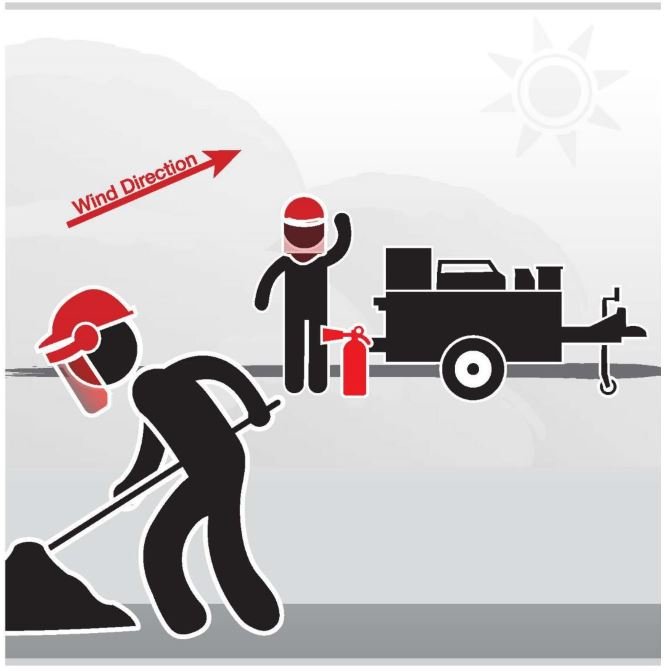Tool Box Talk: Asphalt Fumes: Roofing Operations
3 min readAsphalt fumes cause health effects such as headaches, nausea, and drowsiness. They are also linked to lung cancer. Asphalt kettles cause both continuous exposure to fumes that escape and occasional exposures when the lid is opened for filling or loading. In general, the higher the asphalt temperature, the more fumes are produced.
Bill’s Story
Bill is an asphalt kettle operator for a roofing company. He is careful to use personal protective equipment, including a hardhat, face shield, long-sleeved shirt, gloves, goggles, and leather work boots. He keeps the work area cleaned up and has a fully charged ABC fire extinguisher nearby. Bill started having headaches, drowsiness, and nausea on the job, so he took a week’s vacation. When he returned, his co-workers showed him the new kettle bought because the old one had a damaged lid and was leaking fumes.
- What do you think caused Bill to feel ill?
- Have you ever had any of the symptoms Bill had? If so, what happened?
Remeber This
- Place the kettle downwind, where the operator and others will be least exposed.
- Select an insulated kettle that is the right size forthe job.
- Make sure the kettle has working temperaturecontrols and the proper pumping capacity for itssize.
- Make sure the kettle is in good operatingcondition. Report any defects to the foreman orsuperintendent. Remove all potential fire hazardsfrom the area. Maintain proper ventilation.
- Set the kettle on firm, level ground to avoidtipping or spilling.
- Keep the kettle lid closed as much as possible. Fill thekettle to capacity when reloading; at the same time,check the temperature, stir, and skim.
- Pre-chop the asphalt into easily handled, meltedpieces. Use a safety loading door instead of thelid to fill the kettle.
- The supervisor must block off the kettle area withwarning tape, traffic cones, and signs.
- Consider using fume-suppressing asphalts.
- Keep a fully charged ABC-type fire extinguishernear the kettle.
- Maintain kettle temperatures at least 25 degreesbelow the flash point of the asphalt to preventfires.
Place the kettle downwind, where the operator and others will be least exposed.
Set the kettle on firm, level ground so that it won’t tip over and the asphalt won’t spill.
Make sure the kettle is in good operating condition, and report any defects to your supervisor.
Keep the kettle lid closed as much as possible and maintain proper ventilation.

Other Recent Topics
- Tool Box Talk: Rough Terrain Fork Truck Scaffolds
- Tool Box Talk: Don’t Let Chemicals Get to You
- Tool Box Talk: Hand Grinder Safety
- Tool Box Talk: Lockout and Tagging
- Tool Box Talk: Winter Driving Safety Tips
- Tool Box Talk: Working Around Heavy Equipment
- Tool Box Talk: Rotary Hammers-Hammer Drills
- Tool Box Talk: Carbon Monoxide Poisoning
- Tool Box Talk: Boom Truck Safety
- Tool Box Talk: Biohazard Safety
- Tool Box Talk: Asphalt Fumes: Roofing Operations
- Tool Box Talk: Arc Welding and Fire Safety
- Tool Box Talk: Aerogel Nanoporous Insulation Products
- Tool Box Talk: Aerial Lift Safety
- Tool Box Talk: Heart Risks: AEDs and CPR in the Workplace
- Tool Box Talk: Oil Spill Response
- Tool Box Talk: Pneumatic tools
- Tool Box Talk: Hydraulic Excavators: Lifting with Slings
- Tool Box Talk: Hearing Protection
- Tool Box Talk: Shift Work Dangers
- Tool Box Talk: Excavation
- Tool Box Talk: Hazardous Chemicals- Four Routes of Entry
- Tool Box Talk: Basic Electrical
- Tool Box Talk: Securing a construction Site
- Death of Oregon forestry worker prompts new toolbox talk




